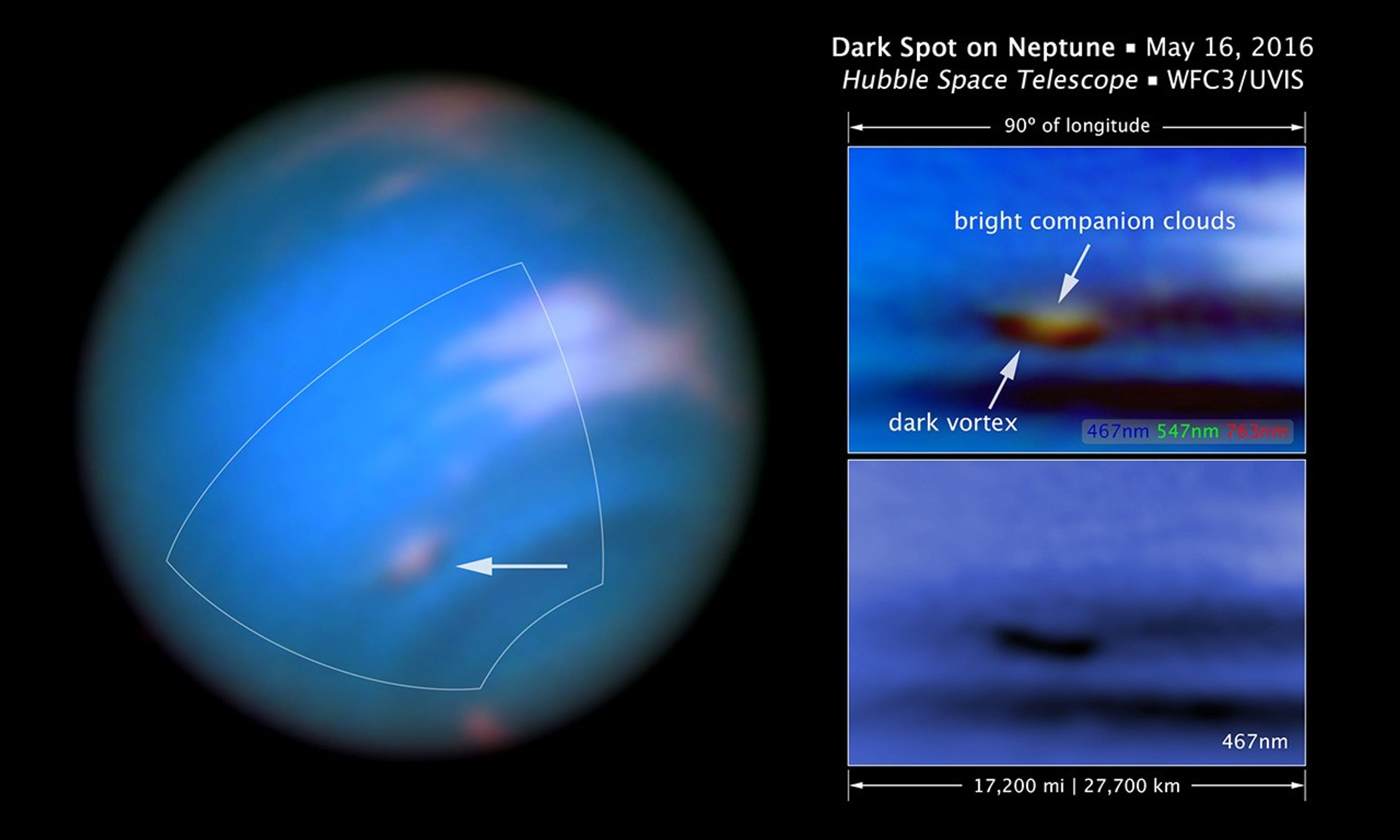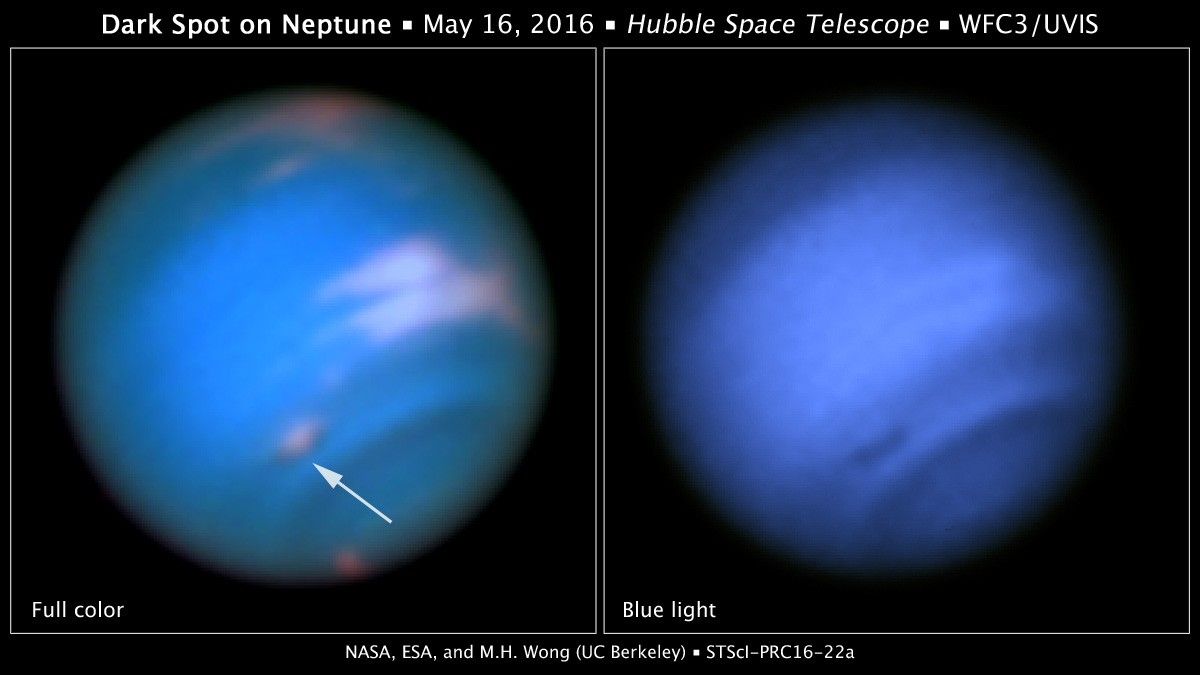1 min read
Scale and Compass Image for Dark Spot on Neptune

This new Hubble Space Telescope image confirms the presence of a dark vortex in the atmosphere of Neptune.
The full visible-light image at left shows that the dark feature resides near and below a patch of bright clouds in the planet's southern hemisphere. The dark spot measures roughly 3,000 miles (4,800 kilometers) across. Other high-altitude clouds can be seen at the planet's equatorial region and polar regions.
The full-color image at top right is a close-up of the complex feature. Pancake-shaped clouds above the spot form when ambient air is perturbed and diverted upward over the vortex. The vortex is a high-pressure system.
The image at bottom right shows that the vortex is best seen at blue wavelengths. Only Hubble has the high resolution required for identifying such weather features on distant Neptune.
Though similar features were seen during the Voyager 2 flyby of Neptune in 1989 and by Hubble in 1994, this vortex is the first one observed on the planet in the 21st century.
In September 2015, the Outer Planet Atmospheres Legacy (OPAL) program, a long-term Hubble Space Telescope project that annually captures global maps of the outer planets, revealed a dark spot close to the location of the bright clouds, which had been tracked from the ground. By viewing the vortex a second time, the new Hubble images, taken by Wide Field Camera 3 on May 16, 2016, confirm that OPAL really detected a long-lived feature. With the new data, the team created a higher-quality map of the vortex and its surroundings.
The team, led by Mike Wong, also included the OPAL team (Wong, Amy Simon (GSFC), and Glenn Orton (JPL)), UC Berkeley collaborators (Imke de Pater, Joshua Tollefson, and Katherine de Kleer), Heidi Hammel (AURA), Statia Luszcz-Cook (AMNH), Ricardo Hueso and Agustin Sánchez-Lavega (Universidad del Pais Vasco), Marc Delcroix (Société Astronomique de France), Larry Sromovsky and Patrick Fry (University of Wisconsin), and Christoph Baranec (University of Hawaii).
About the Object
- DistanceDistanceThe physical distance from Earth to the astronomical object. Distances within our solar system are usually measured in Astronomical Units (AU). Distances between stars are usually measured in light-years. Interstellar distances can also be measured in parsecs.The semi-major axis of Neptune's orbit about the sun is 30.06 astronomical units (roughly 2.8 billion miles or 4.5 billion kilometers).
- DimensionsDimensionsThe physical size of the object or the apparent angle it subtends on the sky.Neptune has a diameter of roughly 30,800 miles (49,600 kilometers) at the equator.
About the Data
- Data DescriptionData DescriptionProposal: A description of the observations, their scientific justification, and the links to the data available in the science archive.
Science Team: The astronomers who planned the observations and analyzed the data. "PI" refers to the Principal Investigator.Data were provided by the HST proposal 14492: M.H. Wong (PI), I. de Pater, J. Tollefson, and K. de Kleer (UC Berkeley), H. Hammel (Space Science Institute), S. Cook (AMNH), R. Hueso and A. Sanchez-Lavega (University of the Basque Country, Spain), A. Simon (NASA/GSFC), M. Delcroix (French Astronomical Society, SAF), L. Sromovsky and P. Fry (University of Wisconsin, Madison), G. Orton (JPL), and C. Baranec (University of Hawaii, Manoa). - InstrumentInstrumentThe science instrument used to produce the data.HST>WFC3/UVIS
- Exposure DatesExposure DatesThe date(s) that the telescope made its observations and the total exposure time.May 15-16, 2016
- FiltersFiltersThe camera filters that were used in the science observations.F467M, F547M, and F763M
- Object NameObject NameA name or catalog number that astronomers use to identify an astronomical object.Neptune
- Object DescriptionObject DescriptionThe type of astronomical object.Planet
- Release DateJune 23, 2016
- Science ReleaseHubble Imagery Confirms New Dark Spot on Neptune
- Credit

This image is a composite of separate exposures acquired by the WFC3/UVIS instrument. In the full globe and top detail image, several filters were used to sample various wavelengths. The color results from assigning different hues (colors) to each monochromatic (grayscale) image associated with an individual filter. In this case, the assigned colors are: Blue: F467M Green: F547M Red: F763M

Related Images & Videos

Dark Spot on Neptune
This new Hubble Space Telescope image confirms the presence of a dark vortex in the atmosphere of Neptune. The full visible-light image at left shows that the dark feature resides near and below a patch of bright clouds in the planet's southern hemisphere. The dark spot measures...
Share
Details
Claire Andreoli
NASA’s Goddard Space Flight Center
Greenbelt, Maryland
claire.andreoli@nasa.gov

































